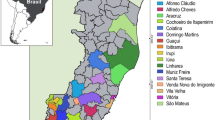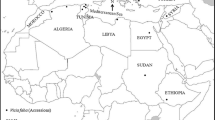Abstract
In this study, we report the use of ISSR to assess genetic diversity and to determine the relationships among ten cultivars of common bean developed in Argentina and three materials from France. ISSR markers resolved two major groups corresponding to the Andean and Mesoamerican gene pools of common bean. We compared the results of previous analysis, performed with RAPD markers (Galván et al., 2001), with the results generated by means of ISSR. It appears that ISSR are better tools than RAPDs to identify beans by gene pool of origin though they did not revealed as many differences between individuals as RAPDs.
Similar content being viewed by others
References
Akagi, H., Y. Yokozeki, A. Imagaki, A. Nkamura & T. Fujimura, 1996a. A codominant DNA marker closely linked to the rice nuclear restorer gene, RF-1, identified with inter-SSR fingerprinting. Genome 39: 1205-1209.
Akagi, H., Y. Yokozeki, A. Imagaki, A. Nkamura & T. Fujimura, 1996b. Microsatellite DNA markers for rice chromosomes. Theor Appl Genet 93: 866-873.
Bornet, B. & M. Branchard, 2001. Nonanchored Inter Simple Sequence Repeat (ISSR) markers: reproducible and specific tools for genome fingerprinting. Plant Mol Biol Rep 19: 209-215.
Bornet, B., F. Goraguer, G. Joly & M. Branchard, 2002. Genetic diversity in European and Argentinian cultivated potatoes (Solanum tuberosum subsp. tuberosum) detected by inter-simple sequence repeats (ISSRs). Genome 45(3): 481-484.
Briand, L., A.E. Brown, J.M. Lenné & D.M. Teverson, 1998. Random amplified polymorphic DNA variation within and among bean landrace mixtures (Phaseolus vulgaris L.) from Tanzania. Euphytica 102: 371-377.
Charters, Y.M., A. Robertson, M.J. Wilkinson & G. Ramsay, 1996. PCR analysis of oilseed rape cultivars (Brassica napus L. ssp. olifera) using 5'-anchored simple sequence repeat (SSR) primers. Theor Appl Genet 92: 442-447.
Chin, E.C., M.L. Senior, H. Shu & J.C. Smith, 1996. Maize simple repetitive DNA sequences: Abundance and allele variation. Genome 39: 866-873.
Duarte, J.M., J.B. Santos & L.C. Melo, 1999. Genetic divergence among common bean cultivars from different races based on RAPD markers. Genet Mol Biol 22(3): 419-426.
Fofana, B., X. Vekemans, P. Du Jardin & J.P. Baudoin, 1997. Genetic diversity in Lima bean (Phaseolus lunatus L.) as revealed by RAPD markers. Euphytica 95: 157-161.
Galván, M., M. Aulicino, S. García Medina & P.A. Balatti, 2001. Genetic diversity among northwestern argentinian cultivars of common bean (Phaseolus vulgaris L.) as revealed by RAPD markers. Genet Res and Crop Evol 48: 251-260.
Gepts, P. & F. Bliss, 1985. F1 hybrid weakness in the common bean. J Hered 76: 447-450.
Gepts, P., T. Osborn, K. Rashka & F. Bliss, 1986. Phaseolin-protein variability in wild forms and landraces of the common bean (Phaseolus vulgaris) evidence for multiple centers of domestication. Econ Bot 40(4): 451-468.
Gepts, P. & F.A. Bliss, 1988. Dissemination pathways of common bean (Phaseolus vulgaris, Fabaceae) deduced from phaseolin electrophoretic variability. II. Europe and Africa. Econ Bot 42: 86-104.
Hamman, A., D. Zink & W. Nagl, 1995. Microsatellite fingerprinting in the genus Phaseolus. Genome 38: 507-515.
Johns, M.A., P.W. Skroch, P. Hinrichsen, G. Bascur & C. Muñoz-Schick, 1997. Gene pool classification of common bean landraces from Chile, based on RAPD and morphological data. Crop Sci 37: 605-613.
Kantety, R.V., X.P. Zeng, J.L. Bennetzen & B.E. Zehr, 1995. Assessment of genetic diversity in dent and popcorn (Zea mays L.) inbred lines using inter-simple sequence repeat (ISSR) amplification. Mol Breed 1: 365-373.
Kojima, T., T. Nagaoka, K. Noda & Y. Ogihara, 1998. Genetic linkage map of ISSR and RAPD markers in einkorn wheat in relation to that of RFLP markers. Theor Appl Genet 96: 37-45.
Maciel, F., L. Gerald & S. Echeverrigaray, 2001. Random amplified polymorphic DNA (RAPD) markers variability among cultivars and landraces of common beans (Phaseolus vulgaris L.) of south-Bazil. Euphytica 120: 257-263.
Métais, I., C. Aubry, B. Hamon, R. Jalouzot & D. Peltier, 2000. Description and analysis of genetic diversity between commercial bean lines (Phaseolus vulgaris L.). Theor Appl Genet 101: 1207-1214.
Mumba, L.E. & N.W. Galwey, 1998. Compatibility of crosses between gene pools and evolutionary classes in the common bean (Phaseolus vulgaris L.). Genet Res and Crop Evol 45: 69-80.
Rohlf, M., 1998. NTSYS-pc. Numerical Taxonomy and Multivariate Analysis System. Version 2.0. Department of Ecology and Evolution. State University of New York.
Rongwen, J., M.S. Akkaya, A.A. Bhagwat, U. Lavi & P. Cregan, 1995. The use of microsatellite DNA markers for soybean genotype identification. Theor Appl Genet 90: 43-48.
Singh, S. & J. Gutiérrez, 1984. Geographical distribution of DL1 and DL2 genes causing hybrid dwarfism in (Phaseolus vulgaris L.), their association with seed size, and their significance to breeding. Euphytica 33: 337-345.
Singh, S.P., 2001. Broadening the genetic base of common bean cultivars: a review. Crop Sci 41: 1659-1675.
Singh, S., R. Nodari & P. Gepts, 1991. Genetic diversity in cultivated common bean. Allozymes. Crop Sci 31: 19-23.
Sneath, P.H. & R.R. Sokal, 1973. Numerical Taxonomy. The Principles and Practice of Numerical Classification. W.H. Freeman and Company. San Francisco, USA.
Tautz, D. & M. Renz, 1984. Simple sequences are ubiquitous repetitive components of eukaryotic genomes. Nucl Acids Res 23: 249-255.
Voysest, O., Valencia, M.C. & M.C. Amezquita, 1994. Genetic diversity among Latin American Andean and Mesoamerican common bean cultivars. Crop Sci 34: 1100-1110.
Yu, K., S.J. Park & V. Poysa, 1999. Abundance and variation of microsatellite DNA sequences in beans (Phaseolus and Vigna). Genome 42: 27-34.
Zietkiewicz, E., A. Rafalski & D. Labuda, 1994. Genome fingerprinting by simple sequence repeat (SSR)-anchored polymerase chain reaction amplification. Genomics 20: 176-183.
Author information
Authors and Affiliations
Rights and permissions
About this article
Cite this article
Galván, M., Bornet, B., Balatti, P. et al. Inter simple sequence repeat (ISSR) markers as a tool for the assessment of both genetic diversity and gene pool origin in common bean (Phaseolus vulgaris L.). Euphytica 132, 297–301 (2003). https://doi.org/10.1023/A:1025032622411
Issue Date:
DOI: https://doi.org/10.1023/A:1025032622411




